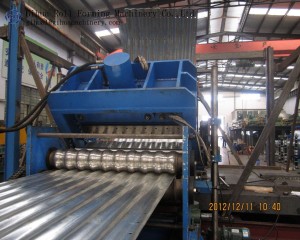The foreign roll forming technology has a history of more than 100 years and is roughly divided into three stages.
The first stage (1838-1909) is the exploration and trial production stage. At this stage, the research on roll forming theory and cold-formed steel is progressing slowly. With the rapid development of the industrial transportation industry, the cold-formed steel produced by the roll forming process can no longer meet user requirements.
The second stage (1910-1959) is the stage of establishing and gradually popularizing the roll forming process.
The third stage (from 1960 to the present) is the stage of rapid development of roll forming production. The development trend of foreign cold-formed steel production can be summarized in several aspects:
1). Production continues to increase
Since the 1960s, the output of foreign cold-formed steel has increased rapidly. This is the general trend. According to the statistics of cold-formed steel in various countries over the years, the output of cold-formed steel and the output of steel have been relatively stable at a certain ratio. It is 1.5:100 to 4:100. For example, the development plan formulated by the former Soviet Union in 1975 stipulated that the output of cold-formed steel in 1990 will account for 4% of steel output. With the improvement of the production process of cold-formed steel, product specifications and varieties continue to increase, and product quality continues to improve The scope of application is expanding. The former Soviet Union was re-regulating the original development plan in 1979, stipulating that it will reach 5% in 1990. Some other countries also plan to increase the output of cold-formed steel. Now the output of foreign cold-formed steel is about 10 million tons per year. It accounts for 3% of the world’s total steel.
2). Research work is deepening
The research work on roll forming theory, forming process and forming equipment is in-depth abroad, and a series of progress has been made in the research on the practical application of cold formed steel. For example, the former Soviet Union and the United States have used electronic computers to study the force and energy parameters in cold bending forming and explore the deformation method with the lowest energy consumption.
3). New processes continue to appear
Since the roll forming process was successfully studied in the United States in 1910, after decades of improvement and perfection, the forming process has become more mature. As the technical and economic effects of cold-formed steel in practical applications are increasingly recognized, cold-formed steel is widely used in various fields of the national economy. Users have more and more stringent requirements for the quality of cold-formed steel, and they require diversification of varieties and specifications. This promotes the continuous improvement of roll forming processes to meet user requirements. Foreign countries have adopted roll forming processes and developed corresponding equipment. Vertical Roll Forming Machine with plug-in type, forming unit with centralized adjustment of forming rolls is referred to as CTA unit (Central Tool Adjustment), straight edge forming unit.
4) The product variety is constantly increasing, and the product structure is constantly updated.
With the development of cold-formed steel production and the expansion of the scope of application, the variety of cold-formed steel continues to increase, product structure is constantly updated, and product standards are gradually improved. With the continuous emergence of new technologies, the range of billet materials and specifications is expanding. Now there are more than 10,000 varieties and specifications of cold-formed steel produced abroad. The specifications of cold-formed steel range from 10mm to 2500mm, and thickness 0.1 mm~32mm. From the perspective of the material of cold-formed steel, it was mainly carbon steel before the 1970s, which accounted for more than 90%. Since the 1970s, through the technical and economic comparison of practical applications, the use of high-strength low-alloy steel, alloy steel and Stainless steel makes the proportion of ordinary carbon steel products decrease year by year, and the proportion of alloy steel, high-strength low-alloy steel and stainless steel products increases year by year.
The Development of Overseas Cold Roll Forming Technology
Post time: Aug-26-2022

